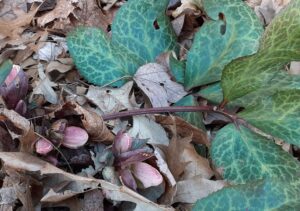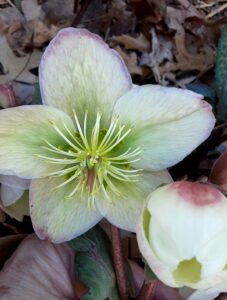Jesus told him, “I am the way, the truth, and the life. No one can come
to the Father except through Me. John 14:6
It was time! The holidays were just a memory and winter had brought its promised encounters with snow and ice and frigid temperatures. But on this particular day in late January, the sun was brilliant, the sky a vivid blue, and the air held a respectable warmth for perusing my front landscape bed in search of life. Plantlife , you say, in January? And there she was, barely visible beneath the bed of leaf mulch we’d provided in late fall. The dark green spotted leaves, leathery in appearance and harsh to the touch because of the spikes at the edges of each leaf, were still alive, though scorched and wind-tattered. Under their protection, I found the object of my search, a cluster of buds waiting to open. They’re sturdy buds, frail bits of fluff wouldn’t stand a chance in our Missouri winters. But she has remarkable capabilities, much like those of her namesake.
, you say, in January? And there she was, barely visible beneath the bed of leaf mulch we’d provided in late fall. The dark green spotted leaves, leathery in appearance and harsh to the touch because of the spikes at the edges of each leaf, were still alive, though scorched and wind-tattered. Under their protection, I found the object of my search, a cluster of buds waiting to open. They’re sturdy buds, frail bits of fluff wouldn’t stand a chance in our Missouri winters. But she has remarkable capabilities, much like those of her namesake.
In the scientific community, she is known as Helleborus orientalis, or more commonly, Lenten Rose. Her name is derived from the bloom time that typically occurs during the Lenten Season, appropriate because next week, we commemorate Ash Wednesday and begin our annual journey on the road to the cross.
 The Lenten Rose has no scientific relationship to the rose. It is, however, related to the buttercup, tracing its roots, pardon the pun, to the genus Helleborus, containing about twenty species in the family Ranunculaceae. In its native Turkey, it could be found growing in more shaded areas and established into large clumps. Here in Missouri, it likes shaded to partly shaded ground with protection from harsh winter weather, in which case it will retain some or all of its dark green leaf color year-round. If it is not protected or our winter is particularly harsh causing its leaves to die back, its perennial traits will bring it back again as spring warms the air.
The Lenten Rose has no scientific relationship to the rose. It is, however, related to the buttercup, tracing its roots, pardon the pun, to the genus Helleborus, containing about twenty species in the family Ranunculaceae. In its native Turkey, it could be found growing in more shaded areas and established into large clumps. Here in Missouri, it likes shaded to partly shaded ground with protection from harsh winter weather, in which case it will retain some or all of its dark green leaf color year-round. If it is not protected or our winter is particularly harsh causing its leaves to die back, its perennial traits will bring it back again as spring warms the air.
The blooms may open anytime from late January to early April depending on the severity of the winter, but those tough, leathery leaves keep my springtime hopes alive each year because I situated my Lenten Rose well. When the right time arrives, the blooms will nod their five-petaled heads atop sturdy stems and provide beauty for as much as eight to ten weeks. Colors vary from greenish-white to pinks and purples. They offer a miracle in the garden and renewed hope that spring is just around the corner. Isn’t that what Easter does for us?
Think about the similarities: Jesus’ early life was quite obscure. He didn’t make a big production of who He was. Such is the cycle of the Lenten Rose. She sits quietly in the bed and strengthens her roots while all the other perennials show off a riot of color. Jesus worked alongside His father as a child and continued to provide what He could for the family until His thirtieth year. When the other plants go to sleep for winter, the Lenten Rose continues to sport her green leaves and when we turn our thoughts to preparation for Holy Week, she is struggling through the coldest part of winter’s onslaught. The previous year’s leaves are certainly damaged but new ones are appearing. Jesus enters Jerusalem to the sound of worshipers welcoming Him with waving palms and shouts of Hallelujah! Lenten Rose is poking buds through the leaf mulch and preparing to show her finery.
But then Jesus’ accusers come forward. They mock Him and torture His body nearly beyond recognition. And the Lenten Rose must face more days of winter weather which often causes some damage to the outside covering of her buds. Like the Lenten rose, Jesus must pass through a dark, cold winter of hatred, jealousy, mockery, and torture. But then, at the culmination of it all, after being nailed to a cruel cross and dying to save us, He rises! Once more, He is in His place in heaven, ready to hear us, to comfort and forgive us, and to love us with an unbridled love. And the Lenten Rose? Her strong, sturdy buds open and she shows us the beauty inside. Even then, her nodding blooms bow down. She honors the Lord in her humility. It is only when I raise her face to the sun that I can see her true beauty. 
Oh yes, I have snowdrops and crocus, daffodils and tulips, each one more showy and colorful than my Lenten Rose and I treasure them. But it is the Lenten Rose that gives me something very tangible to remind me of the sacrifice Jesus made for me. She doesn’t sleep through winter like all the others, she endures it, just like He endured the cross.
Here in Missouri, the weather is always surprising us with its twists and turns, but Jesus and the Lenten Rose are ready for all of it. Don’t you want Jesus to walk with you through all the winters of your life?
Do not be afraid or discouraged, for the Lord will personally go ahead of you. He will be with you; he will neither fail you nor abandon you. Deuteronomy 31:8

